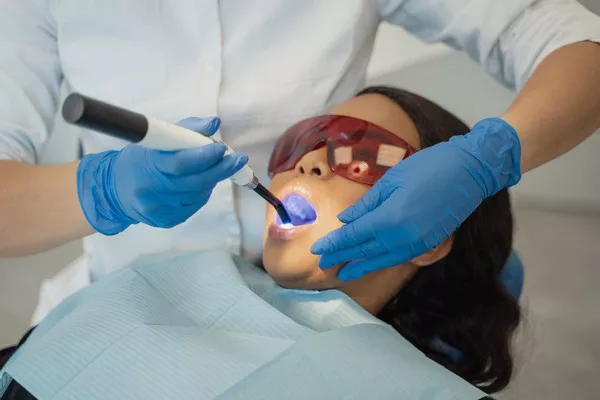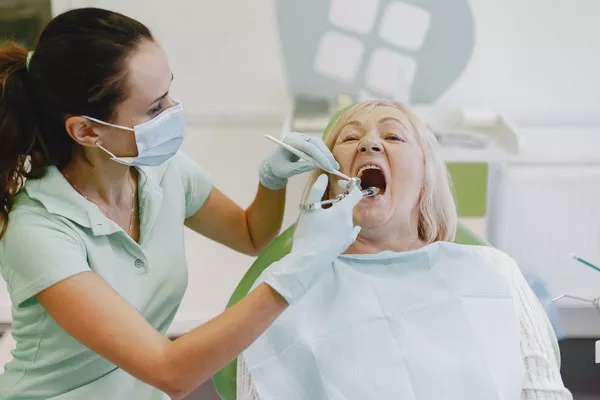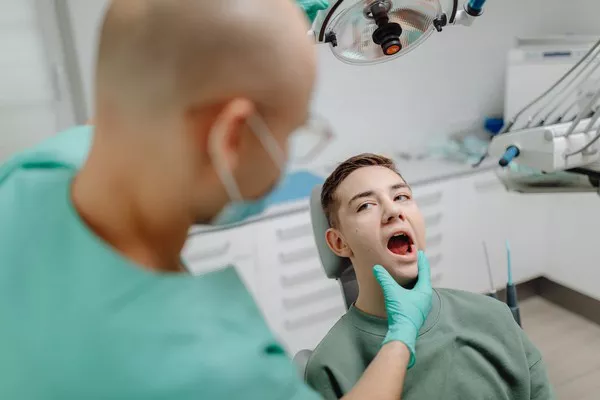Definition of Gingivitis
Gingivitis is a common and mild form of gum disease that causes irritation, redness, and swelling (inflammation) of your gingiva, the part of your gum around the base of your teeth. It is typically caused by poor oral hygiene practices that allow plaque—a sticky film of bacteria—to build up on the teeth and gums. Plaque produces toxins that irritate the gum tissue, leading to inflammation and gingivitis.
The symptoms of gingivitis can vary but often include:
Gum Swelling: The gums may become swollen, tender, or puffy.
Bleeding Gums: Gums may bleed during brushing or flossing.
Bad Breath: Persistent bad breath, despite regular brushing and flossing, can be a sign of gingivitis.
Receding Gums: Gums may start to pull away from the teeth, creating pockets where bacteria can accumulate.
Changes in Gum Color: Gums may appear red instead of their usual pink color.
If left untreated, gingivitis can progress to a more severe form of gum disease called periodontitis, which can lead to tooth loss and other complications.
Duration Without Treatment
The duration of gingivitis without treatment can vary widely from person to person and depends on several factors, including the individual’s overall oral health, the severity of the condition, and their commitment to oral hygiene practices.
For some individuals, mild cases of gingivitis may improve with diligent oral care, including regular brushing and flossing, along with routine dental cleanings. However, in more severe cases or when proper oral hygiene practices are not followed, gingivitis can persist and progress to periodontitis.
Without intervention, gingivitis can linger for weeks, months, or even years, gradually worsening over time. It’s essential to address gingivitis promptly to prevent it from advancing to more severe gum disease.
Self-Care Measures
While professional dental care is crucial for effectively treating gingivitis, there are several self-care measures that individuals can take to manage mild cases of the condition and promote gum health:
Proper Oral Hygiene: Brushing teeth at least twice a day and flossing daily can help remove plaque and prevent gingivitis.
Saltwater Rinses: Rinsing the mouth with a warm saltwater solution can help reduce inflammation and promote healing of the gums.
Chlorhexidine Mouthwash: Over-the-counter mouthwashes containing chlorhexidine may help reduce plaque and gingivitis symptoms when used as directed.
Consistency is key when practicing these self-care measures. Even if symptoms improve initially, it’s essential to maintain good oral hygiene habits to prevent gingivitis from returning.
Importance of Professional Care
While self-care measures can help manage mild gingivitis, professional dental care is essential for diagnosing and treating the condition effectively. Dentists and dental hygienists can provide thorough cleanings to remove plaque and tartar buildup, as well as offer personalized recommendations for improving oral hygiene practices.
During a dental visit, the dentist may also perform a comprehensive examination to assess the health of the gums and identify any signs of gum disease or other oral health issues. Early detection and treatment of gingivitis can prevent it from progressing to more severe forms of gum disease.
Potential Complications
Untreated gingivitis can lead to several complications, including:
Periodontitis: Gingivitis that progresses can develop into periodontitis, a more severe form of gum disease characterized by loss of bone and tissue that support the teeth. Periodontitis can lead to tooth loss and the need for extensive dental treatment.
Tooth Loss: Advanced gum disease can cause teeth to become loose or fall out due to damage to the supporting structures.
Systemic Health Issues: Research has shown that gum disease may be linked to other health problems, including heart disease, diabetes, and respiratory infections.
By addressing gingivitis early and seeking prompt treatment, individuals can reduce their risk of experiencing these complications.
Signs of Improvement or Worsening
Knowing the signs of improvement or worsening of gingivitis is essential for monitoring oral health and knowing when to seek professional help. Signs that gingivitis may be improving include:
Reduction in Gum Swelling: The gums may appear less swollen and tender.
Decreased Bleeding: Gums may bleed less during brushing or flossing.
Improved Breath: Bad breath may diminish with improved oral hygiene.
Conversely, signs that gingivitis may be worsening include:
Increased Gum Swelling: The gums may become more swollen and tender.
Persistent Bleeding: Gums continue to bleed during brushing or flossing.
Receding Gums: Gums may start to recede further, exposing more of the tooth root.
If any of these signs are present, it’s crucial to schedule a dental appointment promptly to prevent the condition from progressing.
Preventive Strategies
In addition to seeking professional dental care and practicing good oral hygiene, there are several preventive strategies individuals can implement to avoid gingivitis:
Regular Dental Check-Ups: Schedule routine dental exams and cleanings to monitor oral health and address any issues promptly.
Quit Smoking: Smoking can increase the risk of gum disease and interfere with the body’s ability to heal gum tissue. Quitting smoking can improve oral health and reduce the risk of gingivitis.
Healthy Diet: Eating a balanced diet rich in fruits, vegetables, and lean proteins can support overall oral health and reduce the risk of gum disease.
By incorporating these preventive measures into their lifestyle, individuals can reduce their risk of developing gingivitis and other oral health problems.
When to See a Dentist
If you experience symptoms of gingivitis, such as swollen or bleeding gums, it’s essential to see a dentist promptly for evaluation and treatment. Waiting for the condition to resolve on its own can allow it to worsen and lead to more severe complications.
Additionally, it’s important to maintain regular dental check-ups even if you’re not experiencing symptoms of gum disease. Routine dental exams and cleanings can help detect early signs of gingivitis and prevent it from progressing.
Conclusion
Gingivitis is a common and treatable condition that requires prompt attention to prevent it from progressing to more severe gum disease. By practicing good oral hygiene, seeking professional dental care, and implementing preventive strategies, individuals can maintain healthy gums and reduce their risk of experiencing complications associated with gingivitis.
FAQs about Gingivitis
1. Can gingivitis go away on its own?
In some cases, gingivitis may improve or even resolve on its own, especially if caught early and addressed promptly with improved oral hygiene practices. However, it’s crucial to note that gingivitis is an early stage of gum disease, and without proper treatment and ongoing oral care, it can progress to more severe forms of periodontal disease. Therefore, while mild cases of gingivitis may show improvement with better oral hygiene, it’s advisable to consult a dental professional for an accurate assessment and appropriate treatment.
2. How do I know my gingivitis is healing?
Signs that your gingivitis is healing include a reduction in gum inflammation, less bleeding during brushing or flossing, and a healthier appearance of the gums. Additionally, you may notice that your gums feel firmer and less tender to the touch. However, it’s essential to continue practicing good oral hygiene habits, such as regular brushing, flossing, and professional dental cleanings, to ensure that gingivitis doesn’t return or progress to more severe gum disease.
3. How long until gingivitis gets bad?
The progression of gingivitis to more severe forms of gum disease can vary depending on individual factors such as oral hygiene habits, overall health, genetics, and lifestyle factors like smoking. In some cases, gingivitis can worsen relatively quickly if left untreated, leading to periodontitis—a more advanced stage of gum disease that can cause irreversible damage to the gums and underlying bone. Therefore, it’s essential to address gingivitis early and seek timely treatment from a dental professional to prevent further complications.
4. What does stage 1 gingivitis look like?
Stage 1 gingivitis is characterized by mild inflammation of the gums, often accompanied by redness, swelling, and occasional bleeding, particularly during brushing or flossing. At this early stage, the damage to the gums is typically reversible with proper oral hygiene and professional dental care. However, if left untreated, stage 1 gingivitis can progress to more severe forms of gum disease, leading to irreversible damage to the supporting structures of the teeth. Therefore, it’s essential to address gingivitis as soon as symptoms appear to prevent further complications.
You Might Be Interested In





























